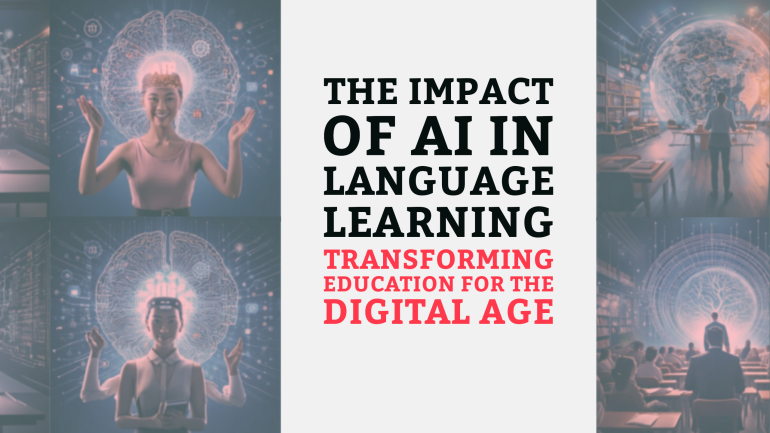This website uses cookies so that we can provide you with the best user experience possible. Cookie information is stored in your browser and performs functions such as recognising you when you return to our website and helping our team to understand which sections of the website you find most interesting and useful.
Table of Contents
TL;DR: Key Takeaways on the Impact of AI in Language Learning
- Personalized Learning: AI tools like Duolingo and Babbel tailor language lessons to individual learners, enhancing engagement and retention through real-time performance assessments.
- Natural Language Processing (NLP): AI technologies provide instant feedback on pronunciation and grammar, allowing learners to improve their language skills more effectively.
- Accessibility and Inclusivity: AI makes language learning more accessible for diverse populations, including those with disabilities, through features like speech recognition and text-to-speech.
- Ethical Considerations: As AI becomes more integrated into education, issues such as data privacy and algorithmic bias must be addressed to ensure equitable learning opportunities for all students.
- Collaborative Learning: AI facilitates global connections among learners, promoting cultural exchange and peer learning, which enriches the language learning experience.
Introduction
In a world increasingly driven by technology, the integration of artificial intelligence (AI) in education is not just a trend; it’s a revolution. The global AI in education market is projected to reach $6 billion by 2025, underscoring the rapid adoption of AI tools in learning environments. For educators, understanding the impact of AI in language learning is essential, as it presents innovative tools that enhance teaching and learning experiences.
This blog post explores how AI is reshaping language education, focusing on personalized learning experiences, improved accessibility, cultural understanding, and ethical considerations. By delving into these transformative aspects, educators will gain valuable insights into effectively leveraging AI tools in their classrooms.
The Role of AI in Language Learning
Personalized Learning
One of the most significant advantages of AI in language learning is its ability to provide personalized experiences. Platforms like Duolingo and Babbel utilize sophisticated algorithms to tailor lessons to individual learners’ strengths and weaknesses.
For instance, when a student engages with Duolingo, the platform assesses their performance in real-time, adjusting the difficulty of exercises based on their progress. This personalized approach not only enhances engagement but also improves retention rates. A case study of a student using Duolingo revealed a remarkable increase in vocabulary acquisition and speaking confidence over just a few months.
Natural Language Processing (NLP)
Natural Language Processing (NLP) is another critical component of AI that significantly enhances language learning. NLP technologies enable real-time feedback on pronunciation and grammar, allowing learners to practice speaking and writing with immediate corrections.
Traditional feedback methods often involve delayed responses from instructors, which can hinder a learner’s progress. In contrast, AI-driven platforms provide instant feedback, helping students correct their mistakes on the spot. This immediate reinforcement fosters a more effective learning environment, as learners can continuously improve their language skills.
Accessibility and Inclusivity
Making Learning Accessible
AI tools are also making language learning more accessible to diverse populations, including those with disabilities. Features such as speech recognition and text-to-speech capabilities empower learners who may face challenges in traditional learning settings.
Educators have reported positive outcomes when using AI tools for special needs students. For instance, a teacher utilizing an AI language app noted that students with speech impairments could practice pronunciation more effectively, leading to increased confidence and participation in class discussions.
Cultural Context in Language Learning
Integrating Cultural References
Understanding cultural context is essential for achieving fluency in any language. AI can provide learners with contextualized language use by integrating cultural references and idiomatic expressions into lessons.
For example, AI platforms can introduce learners to local customs, slang, and cultural nuances, which are crucial for effective communication. This approach not only enriches the learning experience but also prepares students for real-world interactions in their target language.
Data-Driven Insights for Educators
Analyzing Learner Performance
AI systems collect vast amounts of data on learner performance, providing educators with valuable insights to inform their teaching strategies. By analyzing trends identified through data analysis, teachers can tailor their curriculum to better meet the needs of their students.
For instance, an educator who implemented an AI tool in their classroom discovered that students struggled with verb conjugations. Armed with this data, the teacher adjusted their lesson plans to focus more on this area, resulting in improved student performance and understanding.
Trends in AI Language Learning
Increased Engagement through Gamification
Gamification is a powerful trend in AI language learning that significantly boosts learner motivation and engagement. AI language apps often incorporate game-like elements, such as rewards, challenges, and leaderboards, to make learning more enjoyable.
Statistics show that users of gamified language learning apps report higher levels of engagement compared to traditional methods. This increased motivation can lead to more consistent practice and better language acquisition outcomes.
Blended Learning Models
The integration of AI tools in traditional classroom settings is leading to more effective blended learning models. By combining face-to-face instruction with AI-assisted learning, educators can create a more dynamic and interactive learning environment.
A success story from a school that implemented AI tools revealed that students benefited from the flexibility of learning at their own pace while still receiving personalized support from their teachers. This blended approach has proven to enhance overall learning outcomes.
Collaborative Learning Opportunities
AI also facilitates collaborative language learning through platforms that connect learners globally. These platforms enable cultural exchange and peer learning, allowing students to practice their language skills with native speakers from different countries.
For example, a project where students from various countries collaborated on language learning tasks not only improved their language skills but also fostered a sense of global community and cultural understanding.
Ethical Considerations in AI Language Learning
Addressing Data Privacy and Algorithmic Bias
As AI becomes more prevalent in education, ethical considerations surrounding data privacy and algorithmic bias are increasingly important. Educators must be aware of the implications of using AI tools and ensure that they are implemented transparently and responsibly.
Data privacy is a significant concern, as AI systems often collect sensitive information about learners. Educators should advocate for the use of AI tools that prioritize data security and transparency, ensuring that student information is protected.
Algorithmic bias is another critical issue. AI systems can inadvertently perpetuate biases present in the data they are trained on, leading to unequal learning opportunities for different groups of students. Educators must engage in discussions about these issues and advocate for equitable AI practices in education.
Promoting Ethical AI Use
Educators have a vital role in promoting ethical AI use in language learning. This includes selecting AI tools that are designed with inclusivity in mind and ensuring that all students have equal access to learning opportunities.
By fostering a culture of ethical AI use, educators can help mitigate potential risks while maximizing the benefits of AI in language education. This proactive approach not only enhances the learning experience but also prepares students to navigate an increasingly AI-driven world responsibly.
Conclusion
The impact of AI in language learning is profound, offering personalized experiences, enhancing accessibility, and fostering cultural understanding. As educators, it is essential to explore AI tools and consider their integration into language teaching practices to improve student engagement and learning outcomes.
As we look to the future of language learning with AI, educators must remain informed and adaptable in this evolving landscape. What AI tools have you explored in your teaching practice, and how have they transformed your approach to language education? Share your experiences and thoughts in the comments below!
By engaging in this dialogue, we can collectively navigate the challenges and opportunities presented by AI in language learning, ensuring that all students benefit from this technological advancement.
FAQ (Frequently Asked Questions)
- How does AI personalize language learning?
- AI platforms analyze individual learner performance and adapt lessons to target specific strengths and weaknesses, providing a customized learning experience.
- What role does Natural Language Processing (NLP) play in language learning?
- NLP enables real-time feedback on pronunciation and grammar, allowing learners to receive immediate corrections and improve their language skills more effectively.
- How can AI tools enhance accessibility in language learning?
- AI tools offer features like speech recognition and text-to-speech, making language learning more accessible for learners with disabilities or those who face challenges in traditional settings.
- What ethical concerns should educators consider when using AI in language learning?
- Educators should be aware of data privacy issues and the potential for algorithmic bias, advocating for the use of AI tools that prioritize transparency and equitable access for all students.
- How can AI facilitate collaborative learning among language learners?
- AI platforms connect learners globally, enabling cultural exchange and peer learning opportunities, which enhance language practice and foster a sense of community.





